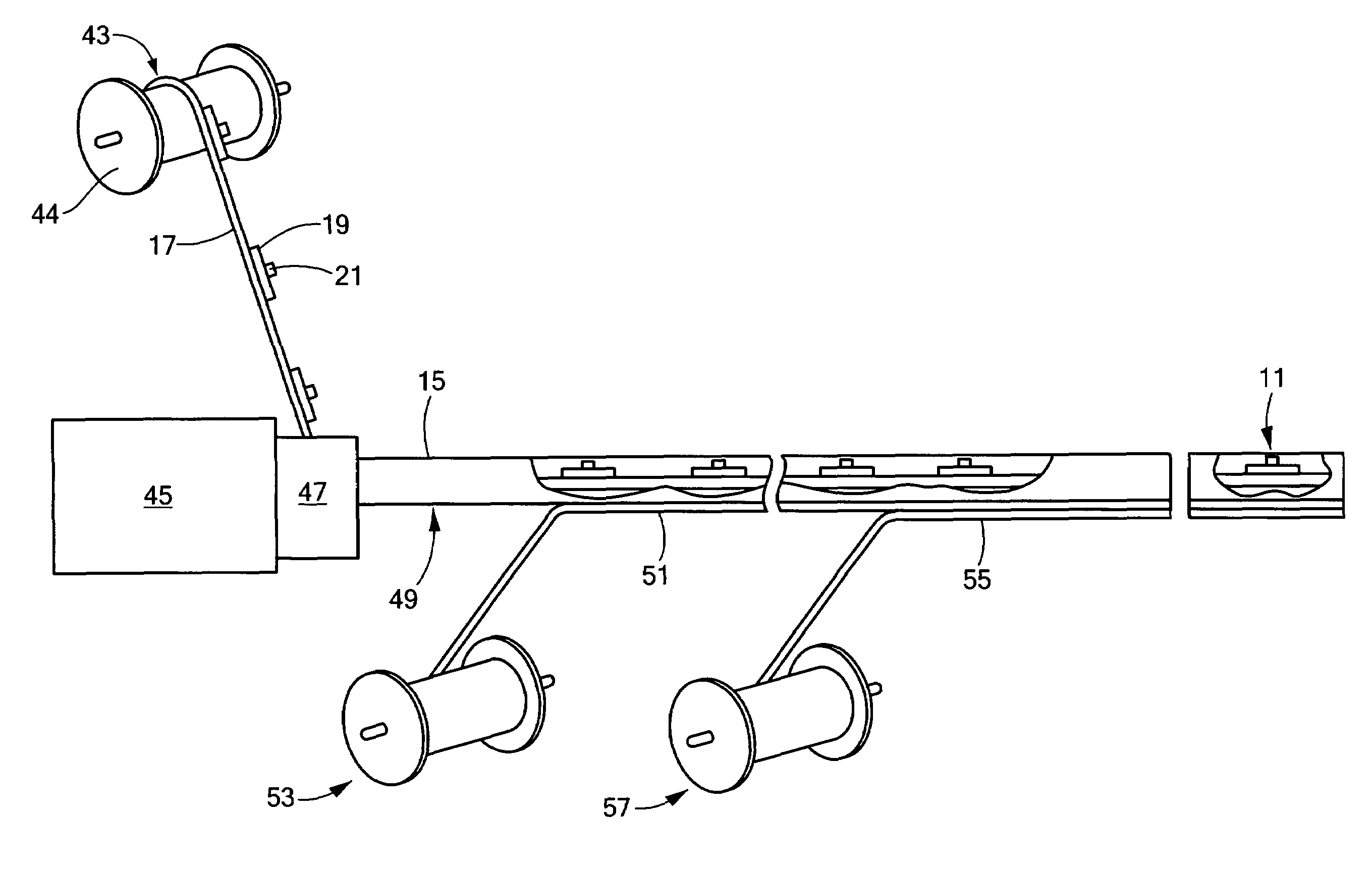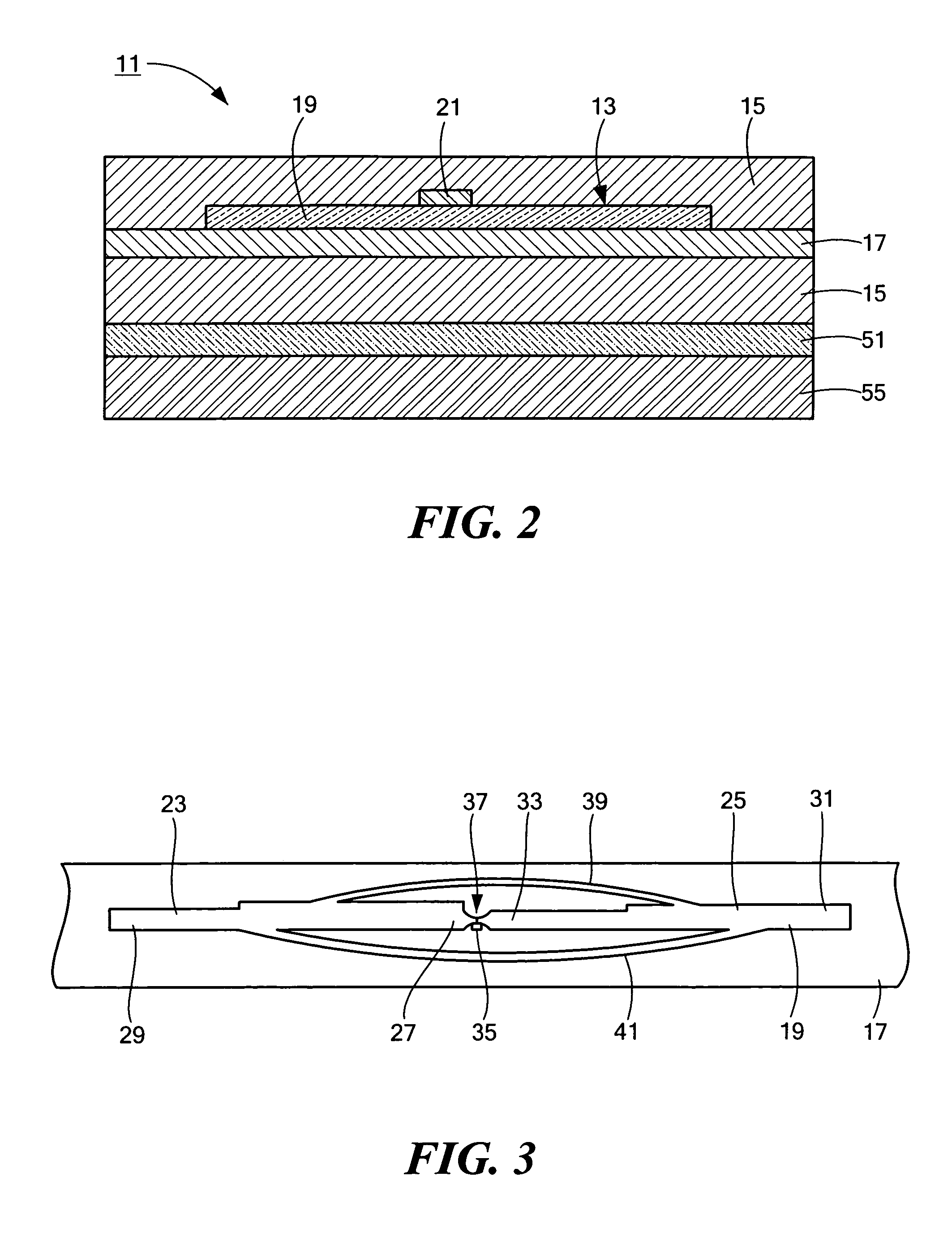RFID tag and method of manufacturing the same
a radio frequency identification and tag technology, applied in the field of wireless communication devices, can solve the problems of high undesirable, high cost of molds, and tags that are not well suited for use on metallic items, and achieve the effect of high throughput ra
- Summary
- Abstract
- Description
- Claims
- Application Information
AI Technical Summary
Benefits of technology
Problems solved by technology
Method used
Image
Examples
first embodiment
[0038]Referring now to FIGS. 1 and 2, there are shown perspective and section views, respectively, of a radio frequency identification (RFID) tag constructed according to the teachings of the present invention and identified generally by reference numeral 11. In operation, RFID tag 11 is designed to be affixed onto a particular item (or packaging therefor) and, in response to an active or passive radio frequency signal, wirelessly transmit information relating to said item.
[0039]RFID tag 11 comprises a radio frequency (RF) inlay 13 and a plastic extrudate 15, extrudate 15 surrounding or enveloping inlay 13 in the manner to be described below.
[0040]RF inlay 13 includes a carrier sheet 17, an antenna 19 formed on carrier sheet 17 and a wireless communication device 21 mounted on antenna 19.
[0041]Carrier sheet 17 preferably comprises a heat-stable polymeric film having a thickness in the range of about 2 mm to 5 mm. Examples of materials suitable for use as carrier sheet 17 include, bu...
second embodiment
[0061]As an example, referring now to FIGS. 5 and 6, there are shown perspective and section views, respectively, of a radio frequency identification (RFID) tag constructed according to the teachings of the present invention and identified generally by reference numeral 111.
[0062]RFID tag 111 is similar to RFID tag 11 in that RFID tag 111 includes a radio frequency (RF) inlay 113 which is identical to RF inlay 13. Specifically, RF inlay 113 comprises an elongated carrier sheet 117 preferably manufactured as a continuous web of heat-stable polymeric film, an antenna 119 printed directly onto the top surface of carrier sheet 117 and a wireless communication device 121 conductively bonded to antenna 119.
[0063]However, RFID tag 111 differs from RFID tag 11 in that RF inlay 113 is positioned within a two-piece plastic casing 115 whereas RF inlay 13 is positioned within a unitary plastic extrudate 15.
[0064]Specifically, casing 115 includes an elongated bottom member 123 which is manufactu...
third embodiment
[0074]Referring now to FIGS. 8 and 9, there are shown perspective and section views, respectively, of a radio frequency identification (RFID) tag constructed according to the teachings of the present invention and identified generally by reference numeral 171.
[0075]Tag 171 is similar in most respects to tag 111, the principal difference between the two tags being that tag 171 does not include a top member 127. Instead, tag 171 includes a plug 177, plug 177 being positioned directly on top of inlay 113 and occupying some or all of the remaining space of cavity 125 of bottom member 123. Accordingly, as can readily be appreciated, tag 171 does not possess an air gap over inlay 113 of the type described above in connection with tag 111.
[0076]Plug 177 may be formed, for example, by extruding molten plastic over inlay 113 until cavity 125 is partially or completely filled and then allowing the molten plastic to cool and harden in place. Alternatively, plug 177 may be formed by pouring int...
PUM
 Login to View More
Login to View More Abstract
Description
Claims
Application Information
 Login to View More
Login to View More - R&D
- Intellectual Property
- Life Sciences
- Materials
- Tech Scout
- Unparalleled Data Quality
- Higher Quality Content
- 60% Fewer Hallucinations
Browse by: Latest US Patents, China's latest patents, Technical Efficacy Thesaurus, Application Domain, Technology Topic, Popular Technical Reports.
© 2025 PatSnap. All rights reserved.Legal|Privacy policy|Modern Slavery Act Transparency Statement|Sitemap|About US| Contact US: help@patsnap.com



